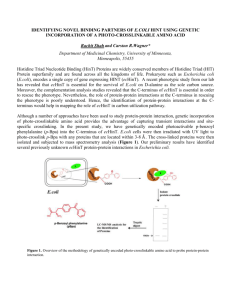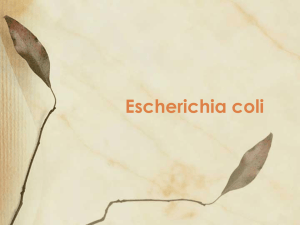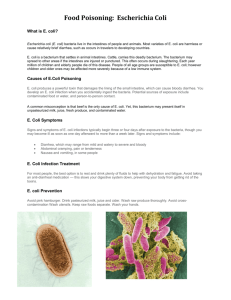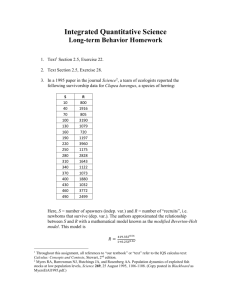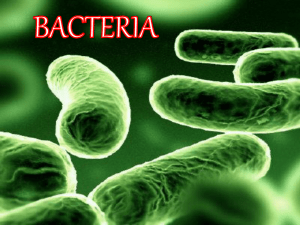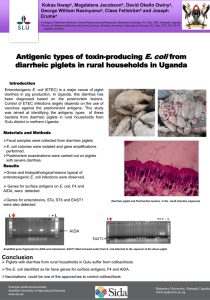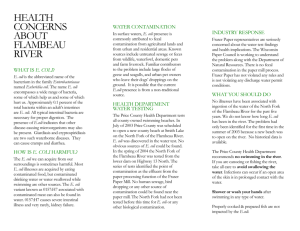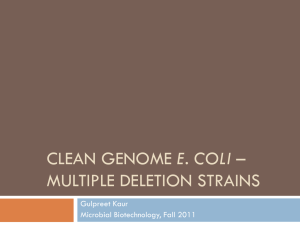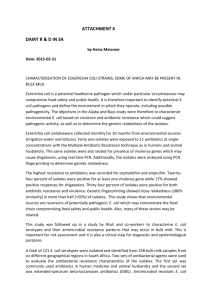E-Coli - sohs
advertisement
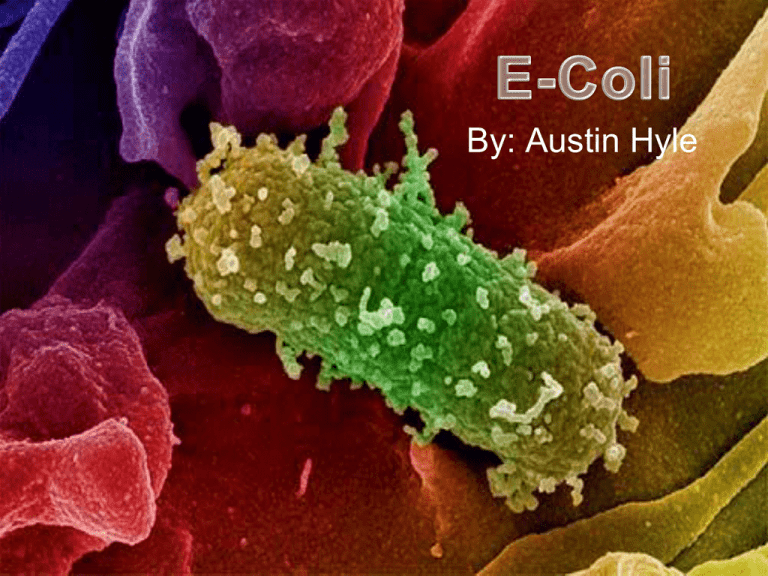
By: Austin Hyle Escherichia Coli • The scientific name for E-Coli is Escherichia Coli. • E-Coli are members of a large group of bacterial germs that inhabit the intestinal tract of humans and other warm blooded animals. Classification • • • • • • • • Domain: Bacteria Kingdom: Bacteria Phylum: Proteobacteria Class: Gamma Proteobacteria Order: Enterobacteriales Family: Enterobacteriaceae Genus: Escherichia Species: Escherichia coli (E. coli) Structure and Metabolism • • E. coli is a facultative anaerobe that colonizes the lower gut of animals but also survives when released into the envionrment They are rodshaped bacteria that possess adhesive fimbriae. E. albertii are nonmotile bacteria that produce acid from the fermentation of D-glucose (with gas), L-arabinose, and D-mannitol and do not ferment sucrose and lactose. They are betagalactosidase positive and fermented D-arabinose, D-fructose, D-galactose, D-mannose, and ribose; however, they were unable to use many uncommon sugars Habitat • E. coli is the most abundant facultatively anaerobic microorganism that is found in the GI tract of humans and mammals. The average human GI tract contains E. coli in the Intestine of a Human upwards of 1 kg (~2.21 lb) of bacteria, and approximately 0.1-1%, these are E. coli. Special Adaptations • Six lines of Escherichia coli adapted for 2,000 generations to a stressful high temperature of 41.5°C were examined on a genome wide scale for duplication/deletion events by using DNA high-density arrays. Toxins • E-coli isn’t usually diseasecausing. • Shiga toxin is one of the most potent toxins known to man, so much so that the Centers for Disease Control and Prevention lists it as a potential bioterrorist agent • Most kinds of E. coli bacteria do not cause disease in humans, indeed, some are beneficial, and some cause infections other than gastrointestinal infections, such urinary tract infections. Gram-Negative • Some strains have genes that cause intestinal infections. • These strains (e.g., type O157:H7—see Gram-Negative Bacilli: E. coli O157:H7 Infection) produce several cytotoxins, neurotoxins, and enterotoxins, including Shiga toxin, and cause bloody diarrhea, which, in 2 to 7% of cases, lead to hemolyticuremic syndrome Function/ Impact • It is a favorite organism for genetic engineering as cultures of it can be made to produce unlimited quantities of the product of an introduced gene. Several important drugs (insulin, for example) are now manufactured in E. coli. However, E. coli cannot attach sugars to proteins so proteins requiring such sugars have to be made in the cells of eukaryotes such as yeast cells and mammalian cells grown in cell culture. WOW! • More than 700 serotypes of E. coli have been identified. The different E. coli serotypes are distinguished by their “O” and “H” antigens on their bodies and flagella, respectively. • The E. coli serotypes that are responsible for the reports of contaminated foods and beverages are those that produce Shiga toxin, because the toxin is identical to that produced by another bacteria known as Shigella dysenteria • Strains of bacteria similar to E. coli have been found in spent printer cartridges -- but only in the cyan ones. Scientists have no explanation. URL’s • • • • • • • • http://www.about-ecoli.com/ http://bioweb.uwlax.edu/bio203/s2008/moder_just/classification.htm http://bioweb.uwlax.edu/bio203/s2008/moder_just/habitat.htm http://microbewiki.kenyon.edu/index.php/Escherichia#Cell_Structure _and_Metabolism http://www.pnas.org/content/98/2/525.full http://users.rcn.com/jkimball.ma.ultranet/BiologyPages/E/Esch.coli.h tml http://www.merck.com/mmpe/sec14/ch173/ch173f.html http://www.topfive.com/amazingtruefacts.shtml

